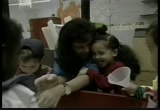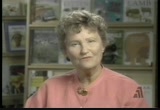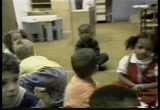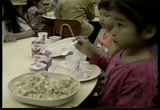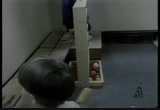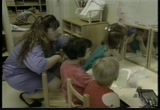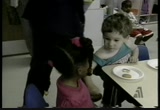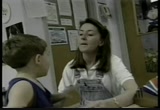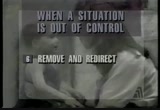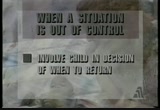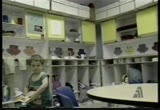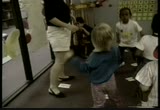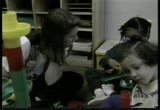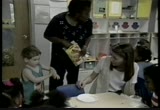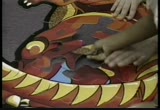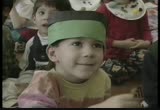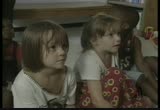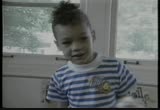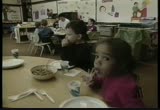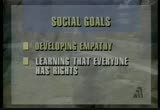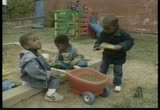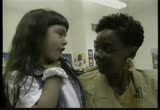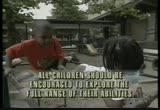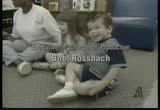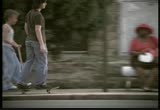tv Democracy Now LINKTV December 3, 2012 8:00am-9:00am PST
8:00 am
funding for this program was provided by... woman: let go of her dress. [child whining] it is not o.k. it is not o.k. let go of her dress. let go. let go! it's gonna rip. woman, voice-over: how many of us have found ourselves in this situation? girl: i need it! i need it! i need to... woman, voice-over: in the heat of the moment, how do you know what to do, what to say?
8:01 am
girl: hi, daniel. woman, voice-over: what can we do to help stop situations from getting out of control and, perhaps even more important, prevent discipline problems from even starting? girl: bye. hello. i'm joanne hendrick. i wrote the book the whole child so that parents, teachers, and caregivers would have an additional source to go to for guidance, direction, and most importantly, for support. our children ask an awful lot of us, as well they should. but just as we need to be there for them, so i hope my book, and now this television series based on the whole child,
8:02 am
can be there for you. on this program, the issue is self-discipline and control, and our challenge is to learn how to teach the youngsters in our care not only to know what is right, but to do what is right. [children laughing] hendrick: we all dream about days like this, when the little ones are on their best behavior and all is peaceful and harmonious. but in the real world, we all know these moments are few and far between. in the real world of childcare, children, like adults, just don't always get along. michael, we got to share! i had this one first. hendrick: how many of us have found ourselves in this situation? in the heat of the moment, how do you know what to do, what to say, how to act? what can we do to help stop situations from getting out of control, and perhaps even more important, prevent discipline problems from even starting?
8:03 am
our goals for this program are simple. together, we're going to learn what to do when a child won't stop doing something he shouldn't be doing, and how to help children control themselves instead of depending on other people to control them. the thing to really remember is that children shouldn't be allowed to hurt themselves or other people or destroy property. and when i say hurt, i mean verbally hurt as well as physically. no matter what those nursery rhymes say, when you're little, words can hurt every bit as much and more than sticks and stones. crucial point to remember is that what discipline is really about is building self-control. boy: we need that right there. hendrick: the process of learning self-control and self-discipline is linked very closely with how a child feels about herself and her relationship to the world. think of this process as being like a child playing with building blocks in a construction project, and we're the construction supervisors,
8:04 am
making sure that with each contact we have with our children, we do or say something that can help build their ability to decide for themselves what's right and wrong and how to control their own behavior. but we must always remember that this is a tall order for such short people. man: miss rachel has been busy setting up lots of different choices for you guys to do. i think ryan-osaurus is ready to go make a choice at station time. and victoria-saurus is ready to go make a choice. zaria-saurus can go make a choice at a station. hendrick: it's wonderful when we can count on children to do the right thing because they want to, not because they have to. one of the best ways to make this happen is to provide as many opportunities as possible for youngsters to make their own choices and decisions. we have to keep in mind that whenever we give a child a choice, we should be prepared to honor their decision.
8:05 am
so, we better think carefully before we offer one. boy: i got to go there, david. woman: "excuse me" is the word we say, and then we ask the person to move. "excuse me" is a way of letting them know you need to be in that space. you don't need to push them away. boy: i hate this! this ain't working. woman: if you want to make another choice, there's other stations open. uh-uh, uh-uh, uh-uh. hendrick: how many times have we caught ourselves asking no-win questions, such as "would you like," or "would you do it, o.k.?" and then we don't like the answer? we've asked children to make a choice, but then we can't accept their decision. it's not fair to the child, and it really puts you on the spot, too. but if you can't ask these questions, what are some questions you can ask? questions that would allow children to make their own choices, choices that will work for both of you. i might say to them, especially if it starts to be a problem, where they interfere in other children's play,
8:06 am
i might say to them, "is there something that you'd like to do?" and i would take their hand and walk them around, rather than telling them, "you need to go over here" or "you need to go over there." then i walk them around the room and say, "look. look what we have here. this is how this works, would you like to do that?" if they shake their head and say "no," i say, "o.k., let's go look at something else and see." so that way you're not forcing your choice on them, but you're allowing them to make that choice of what they would like to do, but still directing them into a more positive activity. woman: do you want to join the group? o.k., get a chair from the other table and pull it over. hendrick: there are some tricky things about choices, though, that you have to remember. for one thing, never end a question with "o.k.?" unless it's really all right with you for the child to say no. it's also very important that our children experience the results and consequences
8:07 am
of their decisions. for instance, if a child chooses to skip his snack and then changes his mind at the last minute, what would you do? how would you respond? and why? there are no absolutes when working with children, and there's always a place for mercy. but i've learned that helping them stick to decisions once they're made teaches youngsters to make responsible choices. and of course, parents and teachers must never forget that in the real world of children, as in the real world of adults, not everything is a choice. not everything's negotiable. sometimes we just have to say "no" to our children and mean it. woman: here you go. there we are, all right. he's smiling. is that good? yeah, all right. all through. hendrick: the foundation for self-discipline and self-control
8:08 am
begins with infancy. what kinds of steps do you think you can take even with infants to promote a child's positive sense of self? steps that, as the child develops, can contribute to maintaining at least some degree of self-discipline and self-control. jack, what are we going to do about a snack today? would you like to be last? no? would you like snack at all? would you? yeah. well, you two are in here, and all of our friends are washing their hands. hendrick: our goal should be to guide and discipline our children so that they feel supported and valued, not judged and rejected. woman: come here. you hold one, and i'll hold one. [whining] here. you hold one, and i'll hold one. there you go. where will we put it? you're going to put yours there? i'm gonna put mine right here. hendrick: warm, nurturing relationships plus firm controls
8:09 am
combined with the reasons for rules can go a long way in promoting self-discipline and self-control in children. woman: it's not o.k. to get it too close to your eyes. i need you to keep it away... girl: i know. from off of your eyelids. girl in red: i'm not doing my eyelids. you're not gonna do your eyes, tanya? it's really pretty if you do your eye shadow. but she's remembering that the rule is that we can't put the face paint around our eyes, 'cause that's how we spread germs. and we spread germs by putting it in our mouth, too. i didn't put it in my mouth. jordan, this is too close to your eye, and that's not a choice. we can help by being consistent with our children in words and deeds. children appreciate knowing just what the rules are at home or in the classroom. that way, they know where they stand and what will happen if they cross the line.
8:10 am
woman: remember, we must keep our glasses on to protect our eyes. woman, voice-over: we teach limits by example. woman: miss hammill will put it on very easy. just for it to protect your eyes, so you won't hit your eyes with the hammer or the nails pop in your eyes, o.k.? woman, voice-over: there's no running in the classroom. the limit for that is safety reasons. it's safer to walk in the classroom. if you're running around a table and you hit the chair, you're gonna get hurt. if you walk around the table, you have a better chance of not hitting that chair, and when they understand that limit in the health perspective, it's better-- they can more readily understand why that's a rule. woman: let go of her dress. it is not o.k. it is not o.k. let go of her dress. let go. let go! it's gonna rip. did shannon have the toy first? [boy speaking indistinctly] but shannon was playing with it. can we take turns? yes?
8:11 am
hendrick: just as a child's understanding of right and wrong is different from an adult's, so are a younger child's perceptions different from an older child, which is why it's so important to approach aggressive behavior according to the age of each youngster. children simply behave differently at different ages. for instance, would you discipline an 18-month-old the same way you would a 5-year-old? why not? girl: ouch! danny! hendrick: physical aggression of one kind or another is very common during the early years and is an unavoidable part of the developmental process. but let's ask ourselves what can we do to reduce the intensity and number of aggressive episodes with the children in our care? of course, preventing problems before they start is the ideal thing to do. can you see how the basketball net is in the center so there's a lot of room and that the teacher is close by? see the way the teacher positions herself in the room
8:12 am
so that all the youngsters can reach her? here are some tips that can help prevent incidents of harmful aggression before they start. position yourself so that you're able to see a large area of the room or the play yard. rather than suddenly stopping an activity, warn your children in advance that time is almost up. remember, our goal is to teach our children how to solve their own problems, since, as adults, they won't have a teacher or a parent there to arbitrate and settle their differences. but what do you do when a situation's already in process, and it could either stop by itself or it could get worse? how do we decide when to get involved and when to let children simply settle the fight between themselves? i have two rules i generally follow which help me decide when to intervene and when not to.
8:13 am
i ask myself, if this continues, what is thlikelihood of somebody getting hurt or property being damaged? and then, if trouble is really brewing, be decisive. take action yourself before the child does. this is critical. [roaring] woman: stevie, chairs are to sit on. i'm sitting. [roaring] sit down. you're going to fall. sit down. [roaring] hendrick: of course, in the real world, children don't always stop hitting, grabbing, or throwing just because we tell them to stop or redirect them. so what do we do when, no matter what we say or what we do, a child simply refuses to listen or obey, and the situation is threatening to get out of control? here are 6 steps i've always found helpful,
8:14 am
and i would follow them in this order, if possible. number 1: warn the child. number 2: remove the child. number 3: discuss feelings and rules. number 4: involve him in the decision as to when he should return. number 5: help him return and be more successful. and number 6: if the child repeats a behavior, remove him again and insist that he choose another place to play. these 6 steps are so important, let's talk about what each of them really means. [roaring] woman: that monster needs to go or you need to leave the room. warn the child and redirect him if he will accept such redirection. it's important to make the child understand that his behavior is up to him. it's his choice, but if he chooses to continue, you'll see to it that you'll carry out your warning.
8:15 am
[roar] it's time to leave. [roaring] you may not sit at the snack table while you're making all of that noise. if necessary, remove the child promptly and keep him with you. if he persists in doing what he's been told not to do, act calmly and promptly-- remove him and insist he sit beside you, telling him he's lost the privilege of doing whatever he was doing. why might this be better than just letting him run off? for one thing, having him sit beside you interrupts what he wants to do. it's a mildly unpleasant consequence of his act. boy: stop it! hendrick: and it also prevents him from substituting something else he'd enjoy or taunting you or running away. now, you need to show me you can do it. while this teacher has the rare opportunity of removing herself and the child from the room, usually teachers can't do that. but you can always have him stay with you.
8:16 am
woman: ready to try again? hendrick: discuss feelings and rules after a reasonable degree of calm has taken place. this is a very important part of handling a discipline crisis. woman: you may say that at home, if your mommy wants you to, but at school, that tiger may not come to school, all right? no. hendrick: be sure to involve the child in the decision about when to go back because taking responsibility for his own behavior is a crucial part of instilling self-control. woman: o.k., will you open the door very carefully? woman: o.k., stevie, are you ready to come pick up the books now? i think you're gonna clean those up. i like that, steve. a good job.
8:17 am
hendrick: it's important to help the child be successful when he does go back so that he has the experience of substituting acceptable for unacceptable behavior. it will probably be necessary to take a few minutes and get him really interested. be sure to congratulate the child when he's settled down, perhaps saying, "now you're doing the right thing, and i'm proud of you." i can hear you saying, "going through these steps is just fine, "but what if he goes back and does the same thing again? what then?" [roaring] well, then we have to go through the steps again. but after that, he has to choose another place to play. you may have noticed that i didn't include any timeouts as one of my intervention steps, and i'll tell you why. although i believe timeout is certainly an improvement over spanking, yelling, or worst yet, shaking a child, it still has its drawbacks. what do you think concerns me most about it?
8:18 am
note that when this teacher says timeout, she does not send the child off to sit by himself. instead, she keeps him with her. woman: you won't do it anymore. you're going to sit in timeout for a few minutes. boy: no. i'm not going to do it no more. i know, that's why you're going to sit in timeout, then you won't do it anymore. jamal, right here. right here. no. right here. hendrick: here's my problem with timeouts. first of all, it's real easy for a child to feel emotionally abandoned when she's sent off by herself. besides that, we frequently become involved in secondary struggles when the child tries to sneak away and we have to catch her. also, many timeouts go on way too long, either because it's such a relief for us to have the child removed, or because we forget she's there. for all these reasons, despite its short-term convenience, in the long run i just feel it's more desirable and helpful to the child to keep her nearby.
8:19 am
girl: it's the boogie walk. boy: poke your nose. woman: you're right. what's it say? step out. [music playing] ♪ step out to the left ♪ and then you step out to the right ♪ ♪ and then you jump, jump, jump ♪ all: the boogie walk! hendrick: although we may not know what to do with it sometimes, we still have to remember that some kind of aggressive behavior is common during the early years. still, there is a limit, and there's much we can do to help our children let off a little steam. one way we can help is to provide plenty of large motor activity and other opportunities for our children to use up their energy. boy: beep, beep. beep, beep. owww! hendrick: in some situations, noise can also be an excellent outlet for expressing aggression. yes, and sometimes there's nothing like a good bashing of the play-doh
8:20 am
or hammering the ol' workbench to relieve stress, tension, and aggressive feelings in a child. girl: she is and you are. woman: are what? you're some scary monsters. some scary monsters? hendrick: my philosophy is that, like our children, we're human, too. but we're also role models, and intense anger can frighten children. that's why it's particularly important for us to recognize and control our flash points, especially on those dark days when it seems like your children know just where and when to push all your wrong buttons. woman: that kind of hurts my feelings when you call me a monster. that makes me sad. you're still a monster. i'm sorry that you feel that way. you're a monster. what kinds of things get under your skin when you're working with children? which one of your buttons do they push that can send you over the edge? woman: they are. they're going to grow. you're right.
8:21 am
stevie, you needed to just look at the plants. o.k., let's just sit down and look at them, o.k.? we're going to have to fix this plant and put all the dirt back. this--you may take a seat, samantha. man: first of all, you have to go into it with a lot of patience. and when that becomes short-lived--and i always, you know, take a deep breath, count to 10, maybe walk away from the situation for a minute, let one of the other teachers take care of it. woman: i'm sorry that you feel that way. i think i am a teacher, and that i'm miss diane. you're just a monster. i'm gonna help mira. hendrick: you can't fool children. let's not pretend to be o.k. when we're actually angry. i say, why not do with our children what we expect them to do with us? let's talk about it. let's get those feelings out and put them right on the table. woman: you know what, erica, you can call me miss diane, or you can call me diane,
8:22 am
but it really hurts my feelings when you call me a monster. hendrick: so, let's review what we've learned about instilling self-control and self-discipline in our children. our challenge in this program was to learn how to teach our youngsters not only to know what is right, but to do what is right. [roaring] stevie, take a seat like the other kids are doing at the snack table, o.k.? you need to say o.k. hendrick: remember, there are ways to stop problems before they start. let's review what we've learned about prevention. consistently position yourself so that you're able to see a large area of the room or play yard at the same time. warn ahead to make transitions easier. woman: ♪ if you're ready for a snack, clap your hands ♪ [clap clap] hendrick: and if these should fail, here are 6 steps that will help you regain control.
8:23 am
number 1: warn the child. number 2: remove her. number 3: discuss feelings and rules. number 4: wait for her to decide when she's ready to return. number 5: help her return and be more successful. and number 6: if necessary, remove again and insist she choose another place to play. and finally, we should recognize that children aren't the only ones who get angry or mad. it helps to know and recognize your own flash points and which buttons are likely to set us off when our children push them, so that then we can hold on to our own self-control. woman: i think generally you'll find that the same child will repeat the same behavior, so you almost feel like you're knocking your head against a wall sometimes because you're asking-- you're trying to help them change a certain behavior, trying to teach them and guide them to change,
8:24 am
but it doesn't happen overnight. woman: lisa, way to go! g@od work! jeremy, way to go! nice work! think that piece might go someplace else? well, look there's some blue here. let's see if we can find a piece that has a little bit of blue on it. hendrick: as caregivers, we must realize that establishing inner controls and self-discipline is a long process that takes many years. it takes a lot of practice and repetition, not only for our children, but for us as well. woman: way to go! nice job! let's face it. even on a good day, childcare's a challenge. none of us handles every discipline situation perfectly. none of us handles every situation perfectly. but when one of those less-than-ideal situations happens,
8:25 am
it's all too easy to spend precious energy on feeling guilty or regretful about how things turned out. but really, we should try to be more gentle on ourselves. rather than feeling guilty, it would be more helpful to think about what the child learned from the experience and, most importantly, what we learned. because when it comes to working with the whole child, the roles can sometimes get very blurred as to who's the teacher and who's the student. see you next time on the whole child. announcer: our country is a brilliant mosaic of colors and cultures. every child in it is unique. itakes effort to keep prejudice from spoiling the picture. how to help children work together with special attention to respecting diversity, next time on the whole child. captioning performed by the national captioning institute, inc.
8:30 am
funding for this program was provided by... man: now, what do we have here? hendrick: once upon a time, this was our image of american preschool education. everybody looked the same. everybody acted the same. everybody was expected to learn in the same way. woman: go, guys, go! hendrick: but times have changed. now we live in a diverse, multicultural, multiethnic world.
8:31 am
and as teachers, we have a tremendous responsibility to not only teach multiculturally but, whenever we can, to practice it in our own classroom. i'm joanne hendrick, author of the whole child and your guide to this video series. in this program, we're going to look at the ways in which we can help by providing, when we can, multicultural and non-sexist education for the children in our care. we'll see children and teachers in action from a number of early childhood programs, family daycare homes, head start, university-based schools, and private infant centers and preschools. we'll hear teachers discuss some of the typical problems they face and their solutions
8:32 am
when trying to create a respectful, open environment for all their children and families. children like to feel good about themselves. they enjoy the feeling of not only knowing who they are but also that others appreciate them, respect them, and value their participation in and contribution to the group. children know differences between people's skin color and gender at a very early age... man: ok, guys. child: hey, des. second child: hey, des. third child: hi. he's got his sister. you're his sister. hendrick: which is why it's so important to begin a program of cross-cultural, non-sexist education as early as possible. woman: what we're going to do is... hendrick: our message is a simple one-- that being different, whether in sex, race, culture, or ability, does not mean inferior.
8:33 am
or everything was blue. not like that. you said you wanted that shirt. now, wear it. woman: doina, ian gets to decide what he wants to wear, just like you picked that pretty white dress for wearing. hendrick: our challenge in this program is to learn how to teach the principle of equity-- that, while we don't all have to get along with each other all the time, all people do have the right to be treated with equal respect, care, and consideration. in teaching equity, we want to emphasize 4 basic principles: that every child has the unique, treasurable gift of individuality to share with others; no matter how unique or different a person is, we each share basic human needs in common with everyone else; all children, no matter their sex, color, abilities, or cultural group, should be encouraged to explore the full range of their abilities and potential; and finally,
8:34 am
we want to emphasize to our children that every individual is a part of a cultural group that has many special qualities to share with others. of course, all this is much easier said than done. teaching about cultural differences can be a very tricky and sensitive business. we have to be careful not to convey to children that those from a different culture are peculiar or strange. and when we encourage a child to share his cultural heritage with others, we want to avoid making him feel like a spectacle. it's a real tightrope. the question is, where do we begin? how do we take the first step? woman: did you know that kwanzaa is-- it goes on for 8 days. it's a celebration with families and food. do you know why we're doing this cooking activity? hendrick: the first thing we should do as teachers and caregivers is to acquire as much knowledge ourselves as we can about different cultures, ethnic groups, and life styles.
8:35 am
woman: that's, like, chinese letters, like "a," "b," "c," our abcs. these are, like, the chinese abcs, all right? is that a place to go to work? child: look at this. woman: huh? hendrick: the children's families are wonderful resources for this kind of information. children learn by our example. woman: i have 7. hendrick: if we show understanding, appreciation, respect, and acceptance for different cultures and life experiences, you can be sure the children in our care will, too. woman: can you help me tonight? second woman: just let the children know everybody is different, but different doesn't necessarily mean bad. you know, there's-- i guess there's just too much of that going on-- too much segregating, too much, you know, "i'm this, and you're that. that's bad." not "i know why it's bad," but because people say. and, you know, there's no basis for it.
8:36 am
it's just one person's opinion that went rampant or whatever. we're trying to say, "we all have differences, but those differences are what make us unique." even beginning with looking at our eyes, our eye color, looking at our hair color, looking at our skin color, so we're starting with self and how we're different, and that's ok. and we play games and do different charts just to recognize that, that your skin might be a different color than mine, but look at how wonderful that is. look at all the different colors we have in our room. woman: guess what i see? i see two boys. does anybody else see two boys? one with blond hair, one with black hair. one that's very fair because what do we have to do when we take john outside? he has to get lots of sunscreen.
8:37 am
and one that's a deep, dark, rich, chocolate color. but they're both boys, so they're the same, but they're different. hendrick: it is very important that we communicate openly and directly with our children about issues of race, ethnicity, and gender. woman: does anybody know what is the same about us? child: no. our skin. woman: we all have skin. hendrick: and we can start by simply not shying away from answering some very basic questions or comments our children may have-- comments that are not intended to hurt. woman: our ears are different. for example, i once heard a child ask in surprise, "you mean, you're black all over?" or we might hear, "how come he walks so funny?" or, "no girls here. this is a guy thing." questions like these should never be hushed up. instead, they should be regarded as not-to-be-missed opportunities to provide matter-of-fact answers,
8:38 am
just as we would answer questions about why the dogs are barking or how come the whistle blows every day at noon. so what do you do when you hear one of your children teasing or making cruel comments about another's disability, skin color, sex, or cultural heritage? first of all, let's not panic or overreact. children don't grow up in a vacuum. they may live in a family where such attitudes are tolerated, if not reinforced, not to mention that we all live in a country that is having its own struggle with racism and bigotry. but no matter what the children hear in other circumstances, ethnic and gender slurs or hostile remarks about another's appearance or disability are not acceptable at the center. it isn't enough just to say, "don't say that. it hurts his feelings." we need to do more. we need to make sure the attacker recognizes why he's really angry.
8:39 am
it isn't because someone's black or mexican or a girl. it's because he took your trike or gave you a push. that's what the angry youngster needs to deal with, just as the insulted child needs to learn more acceptable ways of getting what he wants. i'm not your friend anyway. child: go away, flannery. i'm moving my cubby. all right, natalie. i'm going to go away. bye, natalie. i am not natalie! hendrick: remember, children don't have to accept all other children, but they do have to respect them. the question is, what can we do to help? it was a good choice, if you're arguing. would you like to come over and talk to flannerabout it? uh-uh. ok. when you're ready, you can go talk to her about it. hendrick: it may take a little time and extra effort on our part... flannery: she was fussing at her. leah's fussing at her, and that hurt her feelings. hendrick: but when these insults fly,
8:40 am
our job is to work with the attacker and point out what he's really upset about, what the true source of his anger is so he doesn't transform that aer into prejudice. her horse is beautifuler than ashley's. second child: uh-uh! i did not say that! hendrick: at the same time, victims of such attacks should have ample opportunity to protest and speak up for themselves. insults do hurt, and we can't pretend they don't. woman: her face is looking pretty sad. hendrick: while acknowledging this, the teacher should also make a big point of saying that just because someone says you're something doesn't make it true. while these are not easy or necessarily comfortable situations for us to confront, they can also provide excellent opportunities for us to clear up confusion and to provide accurate information that is vital if our children are to develop healthy attitudes about race, gender, and identity. woman: that sounds like a perfect idea. i bet your bear will make you feel better. i did have a group of girls playing,
8:41 am
and one girl said to the other one, "you get the doll with the brown skin. "that's the ugly doll. you get that one because you have brown skin." and it was very shocking to me to hear that. so it was my job to walk over and talk about skin and that just because this child's skin was a different color didn't mean that she was any different from you, and that's very beautiful, and that doll was very beautiful. and that's why we have lots of different-color dolls-- because we are different colors, and it's beautiful to be all different colors. and so that's why we provide those dolls, so they become more aware of that, but it is tricky. and sometimes you do want to mention it also to the parents so the parents can realize, possibly, what this child is thinking, and maybe they picked up something wrong on something on tv or something.
8:42 am
you try to get to the bottom of it and then be very aware of that. i had a little boy in my program who sort of used a derogatory word, and what i did was, i said, "we don't use those words here, "but every time you use a positive word, what we'll do is, we'll talk about that word." and he started--one day, he didn't say the word. the next day, he didn't say the word, and he started to build on his own vocabulary. so i think when you give a child specific praise and give them specific things to do, it helps them a lot. ♪ falling down ♪ london bridge... hendrick: there may not be much we can do about the racism, bigotry, and prejudice in the rest of the world, but in our own classrooms, there is much work to be done to promote awareness and acceptance of diverse peoples and cultures. ♪ lock him up, lock him up ♪
8:43 am
hendrick: we can start by providing our children with access to a wider range of multicultural materials on a regular basis. let's frequently look over our environment and materials with a multicultural eye while always remembering that the primary purpose of offering these is to generate positive feelings, not teach facts. do we offer our children paints and crayons in a range of skin tones? do we have lots of good books which show all sorts of diverse cultures and ones that counteract gender stereotypes? do the pictures on our walls include people of various ethnic groups? do our children see positive images of people with handicaps? do they have opportunities for positive contacts with such people? woman: this story is called my first kwanzaa book. now, we did some kwanzaa activities today. did everybody help with the planting? yeah. we planted some plants. that was just to talk about a kwanzaa day
8:44 am
that celebrates purpose and activity and being busy. and we made some food, didn't we? hendrick: do we regularly offer the opportunity for discussion and activities about our children's cultural and gender identity? but keep in mind that even though inclusion of materials and activities is important, this kind of thing is just the beginning. it just scratches the surface. what really matters is the respect and liking teachers model when dealing with the other adults and children. so far, we've seen a number of ways to promote a positive attitude towards cultural diversity by highlighting cultural heritage and individuality. our second aim is to emphasize that no matter what culture one is from, all children share common needs and characteristics. children not only need to have their cultural uniqueness welcomed and valued, they also need to realize that different people have many things in common and that they're all alike in some fundamental ways.
8:45 am
in other words, we're all different, and yet, we're all the same color inside. what are we having for lunch today? hendrick: one way to teach our similarities with each other is to emphasize the commonality of biological and psychological needs. for example, if we're talking with a group of children about favorite foods, we can make the point of reminding them that no matter what specific things we like to eat best, all children get hungry, and all people can enjoy eating food together. child: like it? i don't like school. i can tell you're very upset. hendrick: we can also deal with emotions in the same way. no matter who we are, everyone feels mad sometimes, most people want to have friends, and most everyone feels a little upset when their mothers leave them at school. i think flannery's going to watch leah. woman: tara, come here. child: i had it first. you guys have to take turns. hendrick: we can also teach children to consider
8:46 am
the rights and needs of everyone. by developing a program based on positive interaction and multiculturalism, we teach our children that everyone has the same basic rights and privileges, and everyone is treated fairly at school. woman: shoot the ball. the social goals most important to emphasize in relation to cross-cultural education are developing empathy for how other people feel, learning that everyone has rights that are respected by all, and gaining social skills by cooperating rather than only by competing and winning out over others. it's also important, when providing a cross-cultural education, to ensure that your children experience a non-sexist classroom as well. now, what does that mean? well, for starters, all the children in our care, girls and boys, must be encouraged equally to explore the full range of their abilities, feelings, and potential. in the life of the whole child,
8:47 am
long gone are the days when girls were not encouraged to play in sports or hammer away with tools and boys were discouraged from playing house or, heaven forbid, having fun with dolls. well, you hear, you know, "we're playing with the trucks. girls can't play with the trucks." or, "boys can't play with dolls." and they do learn, at a very young age, those different kinds of behaviors. and it's important just for the teacher to reinforce that it's ok for jimmy to be playing with a doll. and one thing that happens in dramatic play a lot is the boys will sometimes put on a dress or put on high heels. and we just need to provide an atmosphere that that's ok. you can pretend to be a girl, or you can pretend to be a boy. and so it's important for the teacher to be there in the setting to provide that, that they're just trying out different roles. hendrick: in the world of the whole child, non-sexist education means
8:48 am
enabling children of both sexes to step beyond narrowly restricted gender roles and stereotypes and helping boys and girls understand and value their own biological uniqueness as males and females. the boys do tend to gravitate to the more physical activities. you know, we're not going to stop them from doing that. and we try to encourage the girls, too. and then, we have some girls who clearly-- they know what they like, and all the goading, all the encouragement is not going to get them to leave housekeeping if that's where they want to be. and then there are some girls, there's nothing you can do to get them out of the big block area. so we let them play where they want. hendrick: in other words, no matter how politically correct we may want to be, boys are not girls, and girls are not boys. child: mr. gerard, i'm playing.
8:49 am
man: that's fine. that's why we come outside--to play. second child: can i play, matt? hendrick: biologically and physiologically, there are differences, and we need to appreciate and value them. for example, research has shown that the physical activity needs of most boys appear to be different from those of most girls. pile. uh-huh! he's going to-- oh, yeah! ooh! hendrick: like it or not, boys are more likely than girls to engage in more rough-and-tumble play. [children shouting indistinctly] boy: stop it! hendrick: and, more times than not, boys tend to be more overtly aggressive than girls are. [children shouting indistinctly] hendrick: although all children need opportunities
8:50 am
for vigorous physical activity, boys do seem to need it specially. their play requires large, sturdy equipment, plenty of space... child: i want you to push me. and a teacher who genuinely welcomes such activity rather than regarding it as a threat to her ability to control the children. as i said, sometimes it can be a real tightrope walk trying to raise or teach a whole child, and it requires a careful balancing act on our part. on one hand, we have to avoid stereotyping, and on the other, we must guard against pushing our children into something that doesn't fit their distinct personalities. like it or not, some girls will be more aggressive than others, some less. some boys will be more passive, some less. and that's ok because if we learned anything in this series, and especially this program,
8:51 am
you can't pigeonhole a whole child, and labels, when we try to apply them, just won't stick. it helps also that-- you know, the parents are helpful in that area, too. i mean, everything that we do multicultural-- it won't mean anything if the parents are completely closed against it. but... i think it maybe allows the children to be a little more accepting of other people's differences. like the children in our classroom, they're very accepting of our special-needs children. they don't look at these children as, "they are different. they can't do this, or they can't do that." they're very helpful to them. i mean, when one of our special-needs children is having trouble with something, another child will go over there and help him out, or they'll tell the teacher and say, "oh, he's having trouble with that." and even so--it just--
8:52 am
just to acknowledge that differences aren't-- to be different isn't to be bad. child: i'm going to kill a lion. hendrick: there's nothing complicated or especially difficult about teaching in a non-sexist, multicultural environment. my grandma, she had this-- remember those collars? yes. well, she had one, but it was square around the neck, kind of. that's ok if that's what you want to wear. that will be perfect. you can make one like that. hendrick: our goal is simply to help each of our children build a foundation of positive attitudes towards themselves and towards people who are different-- a foundation based on our 4 principles of equity. ♪ oh, i was brushing my teeth ♪ ♪ so much fun... hendrick: that every young person has the unique and treasurable gift of individuality to share with others. ♪ so much fun ♪ i would never let the water run ♪
8:53 am
♪ no, i never let the water run ♪ [child speaking indistinctly] hendrick: that no matter how unique or different a person is, we each share basic human needs in common with everyone else. renee, you can't do this. oh, yes, i can. look. just like this. hendrick: that all children, no matter their sex, color, abilities, or cultural group, should be encouraged to explore the full range of their abilities and potential; and finally, that every individual is part of a cultural group that has many special qualities to share with others. well, one of the things that we do is, we have a parent who speaks spanish, and he comes in, and he counts with the children. he counts the alphabet. he tells us little stories. he tells us little jokes, and they see that there's another language beside their own language. they ask questions, and they begin to copy and imitate what they've heard.
8:54 am
bringing in grandparents-- we often do that--to read. some children don't have grandparents, so it kind of gives them a feel for what it's like to have a grandparent. and it broadens their horizons, and they love it. hendrick: children are like fingerprints. no one is quite like the other. [woman makes kissing noise] [woman chuckles] each one is different, distinct, individual, special. woman: ready? come on, alan. ♪ did you ever know that you're my hero? ♪ ♪ you're everything i would like to be ♪ ♪ i can fly higher than an eagle ♪ hendrick: and yet, in so many ways that are just as important,
8:55 am
we are as much alike as we are different. and the good news is, we don't have to teach all this by ourselves. let's keep in mind that the most significant sources of learning about other cultures comes from the families of our children. by encouraging children and their families to share their values, language, and customs, we can provide an invigorating, loving, cross-cultural link between home and school, and ultimately, a link of acceptance and tolerance the child will carry to adulthood. i'm joanne hendrick. see you next time on the whole child. for young children, play is important business. creativity comes from more than crayons, paint, and paste. it can be nurtured in many forms. how to teach children to express themselves through creativity and play, next time on the whole child.
8:56 am
8:57 am
here, kitty, kitty! here, kitty, kitty, kitty! here, kitty, kty you'd think it would be ea to tell which kids had trouble with their eyesight. [ thud ] but that's not always the case. even though one in four children may have a vision problem, eye doctors tell us the symptoms aren't always so obvious. we do know that 80% of all childhood learning is visual. and without good vision, kids can have trouble learning to read. [ girls screaming ] ow! and may fall behind in school. for clues on how to spot the real-life signs of childhood vision problems and what parents can do,
112 Views
Uploaded by TV Archive on

 Live Music Archive
Live Music Archive Librivox Free Audio
Librivox Free Audio Metropolitan Museum
Metropolitan Museum Cleveland Museum of Art
Cleveland Museum of Art Internet Arcade
Internet Arcade Console Living Room
Console Living Room Books to Borrow
Books to Borrow Open Library
Open Library TV News
TV News Understanding 9/11
Understanding 9/11

